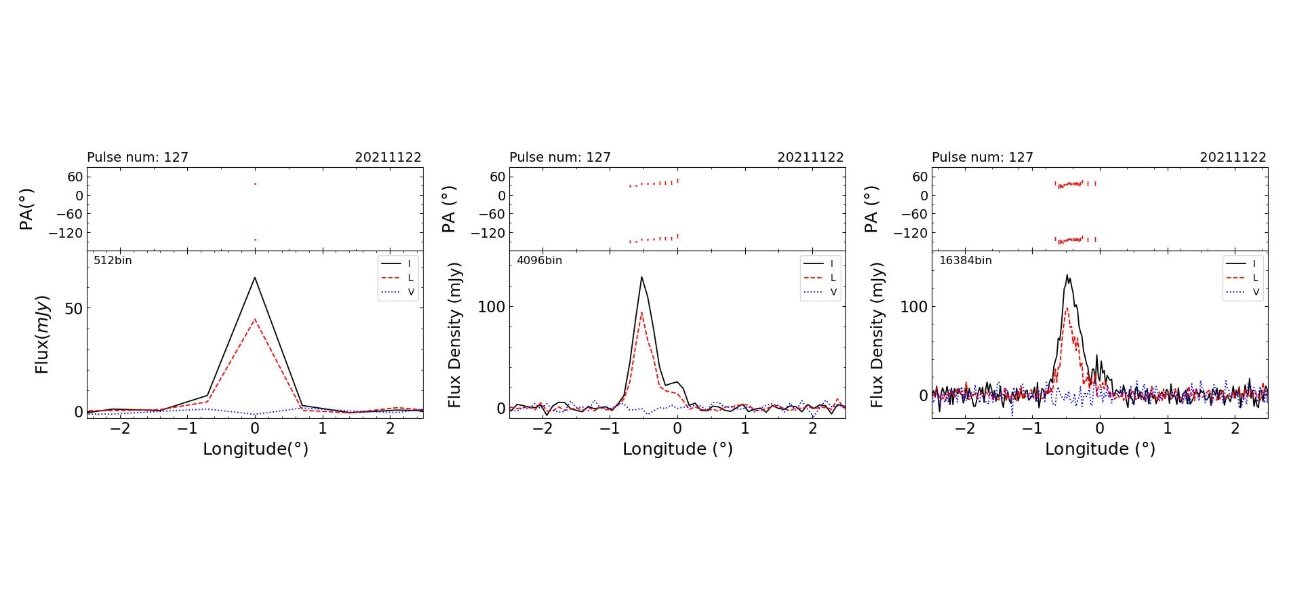Polarized pulse profile of RRAT J1854+0306 with different interphases. From left to right, the 127th pulse observed on 11/22/2021 is displayed with 512, 4096 and 16384 phase bins. The total intensity (𝐼), linear (𝐿) and circular polarization (𝑉) of each pulse are shown by the black and white, red and blue dashed lines in the bottom panel of each plot. PAs of linear polarization greater than 5𝜎𝐿 are indicated by red dots with ± 𝜎𝑃 𝐴 error bars in the upper panels of the graphs. 𝜎𝐿 and 𝜎𝑃 𝐴 represent the uncertainties of L and PA. credit: arXiv (2024). DOI: 10.48550/arxiv.2404.09418
x to close
Polarized pulse profile of RRAT J1854+0306 with different interphases. From left to right, the 127th pulse observed on 11/22/2021 is displayed with 512, 4096 and 16384 phase bins. The total intensity (𝐼), linear (𝐿) and circular polarization (𝑉) of each pulse are shown by the black and white, red and blue dashed lines in the bottom panel of each graph. PAs of linear polarization greater than 5𝜎𝐿 are indicated by red dots with ± 𝜎𝑃 𝐴 error bars in the upper panels of the graphs. 𝜎𝐿 and 𝜎𝑃 𝐴 represent the uncertainties of L and PA. credit: arXiv (2024). DOI: 10.48550/arxiv.2404.09418
Using the 500-meter Aperture Spherical Radio Telescope (FAST), Chinese astronomers examined the radio emission from a rotating radio transient called RRAT J1854+0306. The results of this study were published on the preprint server on April 15 arXivwill further clarify the characteristics of this transient.
Pulsars are highly magnetic neutron stars and emit a beam of electromagnetic radiation. They are usually detected as short bursts of radio emission. However, some of them are also observed through optical, X-ray and gamma-ray telescopes.
Rotating radio transients (RRATs) are a subset of pulsars characterized by diffuse emission. The first objects of this type were detected in 2006 as sporadic pulses with frequencies varying from several minutes to several hours. However, the nature of this transient is still unclear. In general, they are assumed to be normal pulsars that experience strong pulses.
So far, just over 100 RRATs have been found. Therefore, astronomers are interested in studying them closely to improve our knowledge of their still largely unknown nature.
Discovered in 2009, RRAT J1854+0306 has a rotation period of 4.56 s and a dispersion size of 192.4 pc/cm.3. It exhibits occasional strong pulses and is among the most powerful RRATs, allowing the details of its emission to be explored.
A team of astronomers led by Qi Guo of Hebei Normal University in China made highly sensitive observations of RRAT J1854+0306 with the aim of investigating its polarized emission. For this purpose, they used the central beam of the 19-beam FAST receiver with a frequency range of 1000 to 1500 MHz, which was divided into 2048 channels.
The observations showed that the emission from RRAT J1854+0306 is dominated by nulls with a null fraction of about 53.2%, punctuated by narrow (less than 1°) and weak (less than 0.5 mJy) pulses with occasional broad and intense bursts. . . Individual pulses appear to exhibit a variety of profile morphologies, exhibiting single, double, and multiple peaks.
According to this study, the pulses of RRAT J1854+0306 show diverse polarization behaviors. Their degree of linear polarization can reach 100% for some pulses and their circular polarization shows different senses and changes.
“These features are related to the relativistic particle density distribution and their diffusion processes and/or due to diffusion effects. For some pulses, the position angle deviates greatly from the mean, which may be due to the diffusion generated from different plasmas. The authors of the paper explain Given that the conditions of the magnetosphere.
Overall, based on the collected data, the researchers concluded that the polarized emission behavior of RRAT J1854+0306 suggests that its emission originates from a magnetosphere similar to that of conventional pulsars. This could have implications for the general understanding of rotating radio transients, as this finding suggests that RRATs may have a similar physical origin to ordinary pulsars.
more information:
Qi Guo et al., The polarized radio emission of RRAT J1854+0306, arXiv (2024). DOI: 10.48550/arxiv.2404.09418
Magazine information:
arXiv
© 2024 Science X Network
#research #investigates #radio #emission #transient #radio #rotation #RRAT #J18540306
